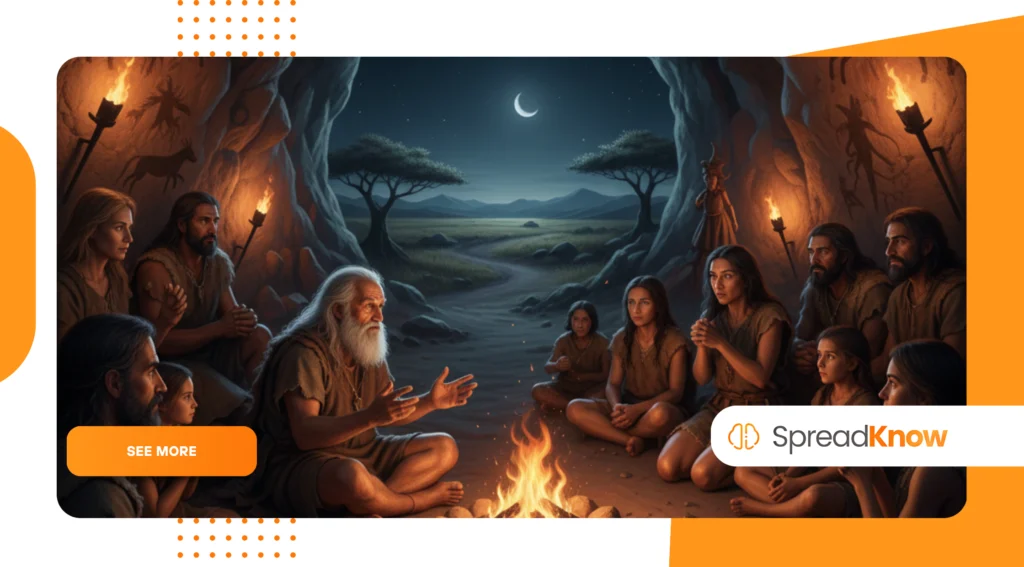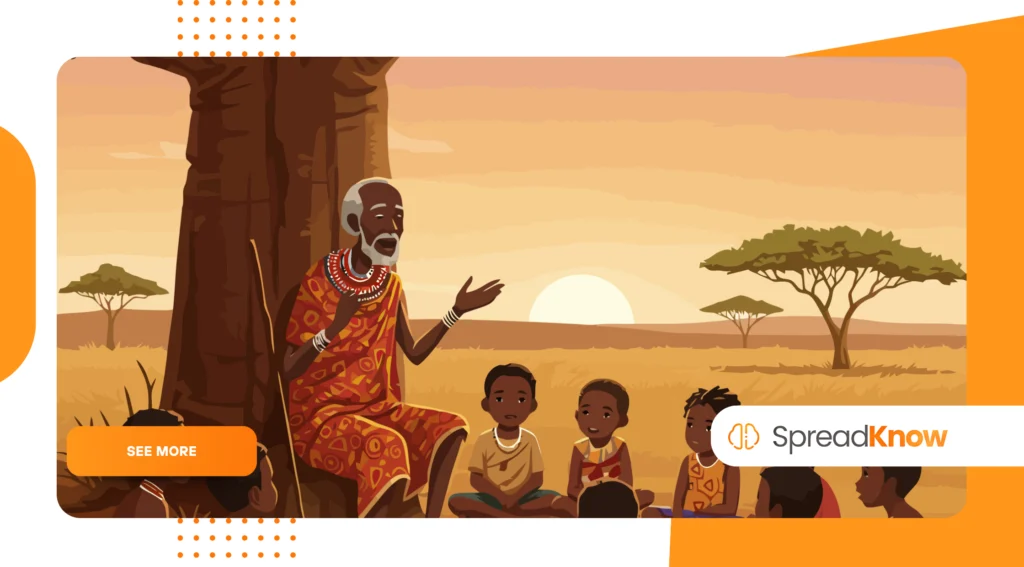Warum das Geschichtenerzählen eine der ältesten Fähigkeiten der Menschheit ist

Warum verstehen Das Geschichtenerzählen gehört zu den ältesten Fähigkeiten der Menschheit. erfordert von uns, über bloße Unterhaltung hinauszublicken.
Anzeigen
Hier geht es nicht nur um Lagerfeuer und Folklore. Es ist ein grundlegendes, biologisches Bedürfnis, das unser Gehirn auf Überleben, Kooperation und Verbundenheit ausgerichtet hat.
Lange bevor die Menschen das Rad erfanden, schufen wir bereits Geschichten.
Diese Erzählungen waren unsere ersten Überlebensratgeber. Sie waren unsere ursprünglichen sozialen Verträge und die wichtigste Art und Weise, wie wir einer chaotischen, oft furchterregenden Welt Sinn verliehen.
Auch heute, im Jahr 2025, ist dieser uralte Impuls noch immer das mächtigste Kommunikationsmittel, das uns zur Verfügung steht.
Anzeigen
In dieser Untersuchung werden wir Folgendes behandeln:
- Warum ist das Geschichtenerzählen eine grundlegende menschliche Eigenschaft?
- Wie nutzten die frühen Menschen Geschichten zum Überleben?
- Warum sehnt sich das menschliche Gehirn nach Geschichten?
- Wann entwickelte sich das Geschichtenerzählen von einer Überlebensstrategie zu einer kulturellen Praxis?
- Was sind die universellen Elemente antiker Geschichten?
- Welchen Einfluss hat diese uralte Fertigkeit auf unsere moderne Welt?
Warum ist das Geschichtenerzählen eine grundlegende menschliche Eigenschaft?
Geschichtenerzählen ist nicht etwas, das wir lediglich gelerntEs ist ein Kernbestandteil unserer kognitiven Architektur. Es beruht auf der einzigartigen Fähigkeit des menschlichen Gehirns, abstraktes, kontrafaktisches Denken zu verarbeiten.
Wir sind vielleicht die einzige Spezies, die gleichzeitig in der Vergangenheit, der Gegenwart und der Zukunft lebhaft leben kann.
Diese Fähigkeit zur mentalen Zeitreise ermöglicht uns etwas Bemerkenswertes. Wir können unterschiedliche Ereignisse zu einer Kette von Ursache und Wirkung verknüpfen.
Diese Abfolge – „Dies geschah, was dazu führte, dass dies als Nächstes passieren könnte“ – ist die grundlegende Grammatik einer Geschichte.
Wir sehen nicht nur einen Löwen und einen Menschen. Wir sehen einen JagdWir erleben nicht einfach nur eine Dürre. Wir gestalten eine Erinnerung der Dürre, um sich auf die nächste vorzubereiten.
Dieser kognitive Sprung ist es, der Instinkt von Strategie unterscheidet.
Unser Verstand ist darauf ausgelegt, Szenarien zu simulieren. „Was wäre, wenn wir hier den Fluss überqueren?“ oder „Was wäre, wenn das Raubtier zurückkehrt?“
Diese Simulationen sind im Wesentlichen private Geschichten. Ihr Teilen wurde zur Grundlage aller menschlichen Planung und zu einem tiefgreifenden evolutionären Vorteil.
+ Kalligrafie lernen: Werkzeuge, Techniken und Praxistipps
Wie nutzten die frühen Menschen Geschichten zum Überleben?
Jahrtausendelang war die mündliche Überlieferung die einzige Wissensdatenbank der Menschheit. Eine Geschichte war die zuverlässigste Methode, um lebensrettende Informationen zu speichern und wieder abzurufen.
Es war ein Gefäß für wichtige Daten, umhüllt von einer emotionalen Hülle.
Stellen Sie sich eine frühe menschliche Gruppe vor. Ein Mitglied isst eine bestimmte leuchtend rote Beere und erkrankt daraufhin schwer.
Die Gruppe verfügt nun über eine entscheidende Information: „Rote Beeren = Krankheit.“ Wie geben sie diese Information an ihre Kinder und Kindeskinder weiter?
Sie erstellen kein Flussdiagramm. Sie erzählen eine Geschichte. Sie gestalten eine warnende Geschichte über ein ungehorsames Kind oder einen gierigen Geist.
Die emotionale Wirkung der Erzählung sorgt dafür, dass die Lektion viel besser im Gedächtnis bleibt als eine bloße Tatsache.
Über die reine Datenübertragung hinaus waren Geschichten das Bindeglied für den sozialen Zusammenhalt. Anthropologische Studien moderner Jäger- und Sammlergruppen, wie der Ju/'hoansi der Kalahari, zeigen, dass das nächtliche Geschichtenerzählen unerlässlich ist, um Konflikte zu lösen, soziale Normen zu festigen und eine gemeinsame Gruppenidentität zu schaffen.
Geschichten definierten „uns“. Sie vereinten große Gruppen von weitgehend Fremden auf ein gemeinsames Ziel.
Diese Übereinstimmung ermöglichte es den Menschen, in einem Ausmaß zusammenzuarbeiten, wie es keiner anderen Spezies möglich war, und ermöglichte Aufgaben wie koordinierte Jagden, komplexe Wanderungen und den Bau früher Siedlungen.
Lesen Sie auch: Die Entwicklung der Schriftsysteme auf der ganzen Welt
Warum sehnt sich das menschliche Gehirn nach Geschichten?
Unser Gehirn ist nicht für Listen oder Tabellenkalkulationen optimiert, sondern für Erzählungen. Die Neurowissenschaft hat in den letzten zwei Jahrzehnten überzeugende Beweise dafür geliefert, warum. Das Geschichtenerzählen gehört zu den ältesten Fähigkeiten der Menschheit.Es handelt sich um ein biologisches Ereignis.
Wenn man tief in eine Geschichte eintaucht, schüttet das Gehirn einen wirkungsvollen Cocktail aus Neurotransmittern aus. Einer der wichtigsten ist Oxytocin.
Dies ist das „Vertrauenshormon“ oder „Empathiemolekül“. Es ist die gleiche Chemikalie, die bei der Geburt und in Momenten tiefer sozialer Bindung freigesetzt wird.
Diese chemische Reaktion fördert Empathie und verbindet uns emotional mit den Figuren der Geschichte und damit auch mit dem Erzähler.
Es schafft buchstäblich Vertrauen zwischen Sprecher und Zuhörer und macht Erzählungen so zu einem wirkungsvollen Instrument der Überzeugung.
Darüber hinaus enthüllten Forschungen von Neurowissenschaftlern wie Uri Hasson in Princeton ein Phänomen namens „neuronale Kopplung“.
Während jemand eine Geschichte erzählt, beginnen sich die Gehirnaktivitätsmuster des Zuhörers mit denen des Erzählers zu synchronisieren. Bei beiden werden dieselben Hirnareale aktiviert.
Das ist kein passives Zuhören. Der Zuhörer erlebt die Geschichte in einem sehr realen Sinne, als wäre es seine eigene Erinnerung.
Der sensorische Cortex wird aktiviert, wodurch sie den Rauch „riechen“ oder die Kälte „fühlen“ können. Deshalb wirkt eine Geschichte so real.
Erzählungen dienen auch als grundlegende Struktur für das Gedächtnis. Unser Gehirn verwendet Schemata oder geschichtenartige Strukturen, um Erfahrungen abzuspeichern.
Fakten sind schwer fassbar. Doch Fakten, die in eine Figur, einen Konflikt und dessen Lösung eingebettet sind, werden beinahe unvergesslich.
+ Die wichtigsten Erfindungen, die die Menschheitsgeschichte verändert haben
Wann entwickelte sich das Geschichtenerzählen von einer Überlebensstrategie zu einer kulturellen Praxis?

Die Grenze zwischen Überleben und Kultur ist kaum zu ziehen, denn Kultur ist im Grunde nichts anderes als eine verfeinerte Sammlung von Überlebensstrategien.
Wir können aber die physischen Beweise dafür sehen, dass sich das Geschichtenerzählen von rein praktischen zu zutiefst spirituellen Aspekten entwickelt hat.
Betrachten wir die großartigen, geheimnisvollen Höhlenmalereien von Lascaux in Frankreich. Diese über 17.000 Jahre alten Werke sind keine bloßen Kritzeleien. Sie sind keine einfachen Tierdarstellungen. Sie sind ganze Szenen.
Kunsthistoriker und Anthropologen interpretieren diese Tafeln überwiegend als anspruchsvolle Proto-Erzählungen.
Sie schildern komplexe Jagdexpeditionen, Misserfolge, Erfolge und vielleicht sogar schamanische Reisen in die Geisterwelt. Es sind die ersten überlieferten Geschichten der Menschheit.
Mit der zunehmenden Komplexität der Sprache entwickelten sich auch die Erzählungen. Geschichten entstanden, um das Unerklärliche zu erklären.
Sie beantworteten die Fragen, die den frühen Menschen wohl umtrieben: Was ist das für ein Feuer am Himmel? Warum wechseln die Jahreszeiten? Was geschieht, wenn wir sterben?
Dies ist die Wiege von Mythologie, Religion und Folklore. Das waren nicht nur Märchen.
Es handelte sich um die ersten großen, vereinheitlichenden Theorien der Menschheit – umfassende Erzählungen, die den gesamten Kosmos ordneten und jedem Individuum eine Rolle darin zuwiesen.
Was sind die universellen Elemente antiker Geschichten?
Was wirklich rätselhaft ist, ist Wie Diese alten Geschichten ähneln sich sehr. Vom Sand Mesopotamiens bis zum Dschungel des Amazonas – Mythen, die von Kulturen geschaffen wurden, die sich nie begegneten, teilen die gleichen grundlegenden Elemente.
Dies deutet auf ein gemeinsames psychologisches Rahmenwerk hin.
Der Gelehrte Joseph Campbell identifizierte dieses Muster bekanntermaßen in seinem Werk. Der Held mit den tausend GesichternEr nannte es den „Monomythos“ oder die Heldenreise. Diese Struktur findet sich nahezu überall.
Es beschreibt einen Protagonisten, der aus seiner gewohnten Welt in ein Reich des Abenteuers gerufen wird.
Sie müssen Prüfungen bestehen, treffen auf Mentoren, stellen sich ihrer größten Angst (dem „Drachen“) und kehren schließlich verwandelt nach Hause zurück und bringen einen „Segen“ für ihre Gemeinschaft mit.
Die Beständigkeit dieser Struktur – von Gilgamesch bis Die Odyssee Zu Star Wars—zeigt, dass Das Geschichtenerzählen gehört zu den ältesten Fähigkeiten der Menschheit. weil es unsere eigene psychologische Entwicklung widerspiegelt.
Wir alle durchlaufen unsere eigenen Prüfungen und Wandlungen.
Diese universellen Archetypen fungieren als gemeinsame Sprache. Sie bieten eine vorhersehbare, verlässliche Landkarte, um sich in den Komplexitäten des Lebens zurechtzufinden.
Tabelle: Zentrale Erzählarchetypen und ihre Funktion
| Archetyp | Hauptrolle in der Geschichte | Universelle Funktion |
| Der Held | Der Protagonist, der sich auf den Weg macht. | Stellt die Reise des Egos zur Selbstfindung und Transformation dar. |
| Der Mentor | Der weise Ratgeber, der Werkzeuge und Ratschläge bereitstellt. | Verkörpert Weisheit, Gewissen und das Wissen vergangener Generationen. |
| Der Schatten | Der Antagonist; der „Drache“ oder Bösewicht. | Stellt die inneren und äußeren Hindernisse dar, die wir überwinden müssen. |
| Die Schwelle | Der Punkt, an dem es kein Zurück mehr gibt. | Steht für die Bereitschaft zum Wandel und die Auseinandersetzung mit dem Unbekannten. |
| Die Rückkehr | Die Rückkehr in die gewohnte Welt. | Stellt die Wiedereingliederung neuer Erkenntnisse in die Gemeinschaft dar. |
Welchen Einfluss hat diese uralte Fertigkeit auf unsere moderne Welt?
Dieser uralte Impuls ist kein verstaubtes Relikt. Im Jahr 2025, in einer Welt, die von digitalem Lärm und Big Data überschwemmt wird, ist authentisches Storytelling zur wertvollsten Währung geworden.
Die Technologie ändert sich, die Neurobiologie jedoch nicht.
Wir ertrinken in Informationen, aber hungern nach Sinn. Storytelling ist das einzige Mittel, um diese Kluft zu überbrücken. Es ist der Filter, mit dem wir Rohdaten in menschliche Erkenntnisse verwandeln.
Im Bereich der Führung sind die effektivsten CEOs nicht diejenigen mit den besten Tabellenkalkulationen. Sie sind die besten Geschichtenerzähler.
Sie nutzen Erzählungen, um Tausende von Mitarbeitern auf eine gemeinsame Mission einzuschwören, ein Scheitern als Lehre darzustellen oder eine Zukunftsvision zu verkaufen.
Im Marketing sind Konsumenten immun gegen Produktlisten. Marken verkaufen nicht mehr nur ein Produkt, sondern eine Identität, eine Überzeugung oder die Zugehörigkeit zu einer „Gruppe“.
Das ist reine, uralte Erzählstrategie, angewendet auf den modernen Handel.
Selbst komplexe Bereiche wie die Datenwissenschaft sind heute auf „Data Storytelling“ angewiesen. Ein Terabyte an Daten ist nutzlos, solange ein Mensch sie nicht in eine Geschichte einwebt, die erklärt Warum Es ist wichtig und Was Das sollten wir als Nächstes tun.
Erfahren Sie von der Harvard Business Review, wie moderne Führungskräfte Narrative nutzen, um ihre Strategie voranzutreiben.Eine unverzichtbare Fähigkeit im heutigen komplexen Geschäftsumfeld. Dieses uralte Werkzeug ist zweifellos der Höhepunkt moderner Kommunikation.
Fazit: Das Betriebssystem der Menschheit
Wir erzählen Geschichten nicht nur zur Unterhaltung, sondern um zu existieren. Vom ersten Primaten, der „Gefahr“ durch Gesten signalisierte, bis hin zu den KI-Modellen von 2025, die komplexe Drehbücher generieren, ist das zugrundeliegende Ziel dasselbe: Ordnung ins Chaos zu bringen.
Wir nutzen Erzählungen zur Zusammenarbeit, zum Erinnern, zum Warnen und zur Inspiration. Sie sind unsere erste und beständigste Technologie. Sie ermöglichen es uns, ein ganzes Leben an Weisheit in wenigen Minuten abzurufen.
Letztlich, Das Geschichtenerzählen gehört zu den ältesten Fähigkeiten der Menschheit. Denn es ist überhaupt keine Fähigkeit. Es ist unser Betriebssystem.
Sie ist die Sprache des menschlichen Geistes und wird unser mächtigstes Werkzeug bleiben, solange wir Menschen bleiben.
Um eine bessere Zukunft zu gestalten, mit Ihrem Publikum in Kontakt zu treten oder sich selbst einfach besser zu verstehen, müssen Sie zunächst die Macht der Geschichten verstehen, die Sie erzählen.
Häufig gestellte Fragen (FAQ)
Frage 1: Ist das Geschichtenerzählen wirklich ein Alleinstellungsmerkmal des Menschen?
Während andere Tiere über komplexe Kommunikationsformen verfügen (wie Bienentänze oder Walgesänge), ist das menschliche Erzählen einzigartig. Es beruht auf der „Verschiebung“ – der Fähigkeit, über Dinge zu kommunizieren, die nicht physisch anwesend sind (Vergangenheit, Zukunft, abstrakte Konzepte). Es beinhaltet auch die Theory of Mind, also das Verständnis für den mentalen Zustand anderer, was für die Gestaltung von Erzählungen mit komplexen Charakteren und Absichten unerlässlich ist.
Frage 2: Wie kann ich diese alten Erzähltechniken heute anwenden?
Sie können das Konzept der „Heldenreise“ auf Ihre eigene Marke anwenden und Ihren Kunden als Helden und Ihr Produkt als Mentor oder Werkzeug positionieren, das ihm zum Erfolg verhilft. Vermeiden Sie in Präsentationen die bloße Auflistung von Fakten und verpacken Sie Ihre Daten stattdessen in eine Geschichte. Beginnen Sie mit dem Problem (dem Konflikt), stellen Sie die Lösung (den Höhepunkt) vor und präsentieren Sie das Ergebnis (die Lösung).
Frage 3: Was ist der „neuronale Kopplungseffekt“ beim Geschichtenerzählen?
Neuronale Kopplung ist der wissenschaftliche Begriff für das Phänomen, bei dem sich die Gehirnaktivität des Zuhörers während des Erzählens mit der des Sprechers synchronisiert. Dieses Phänomen, entdeckt von Forschern der Princeton University, bedeutet, dass der Zuhörer die Ereignisse, Emotionen und Sinneswahrnehmungen der Geschichte so erlebt, als würden sie ihm selbst widerfahren. Dies führt zu einem deutlich besseren Verständnis, größerem Vertrauen und einer tieferen emotionalen Verbundenheit.
